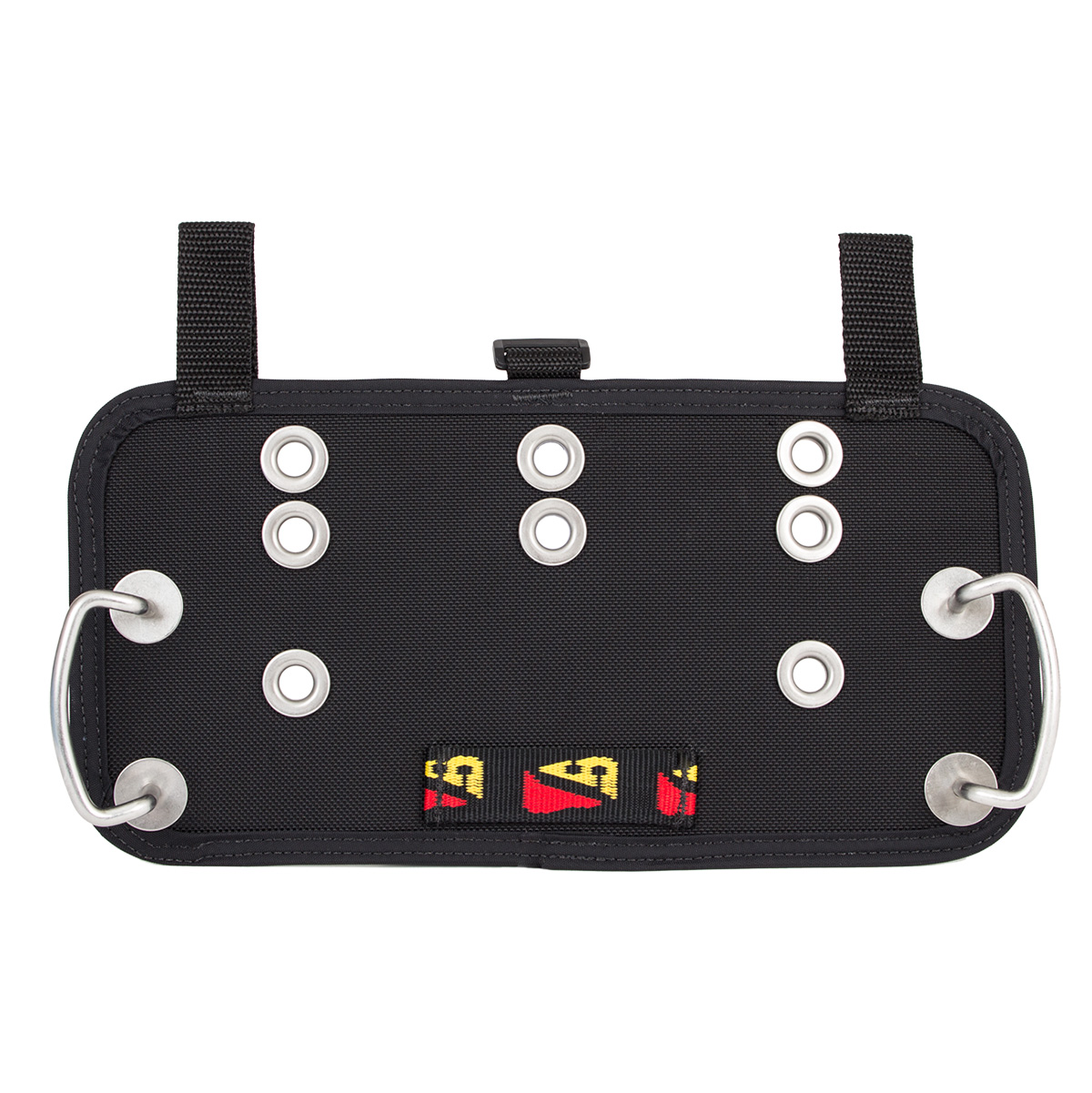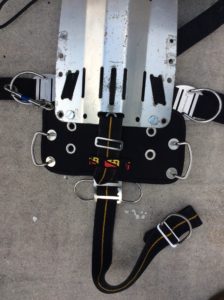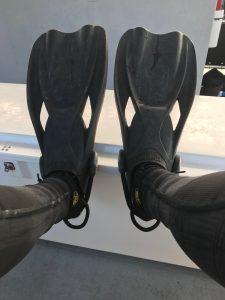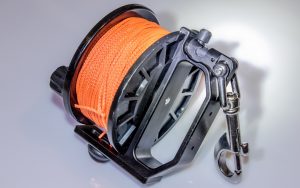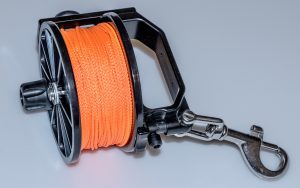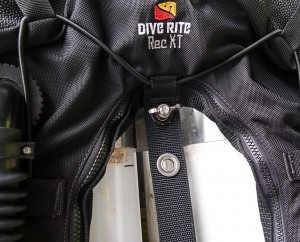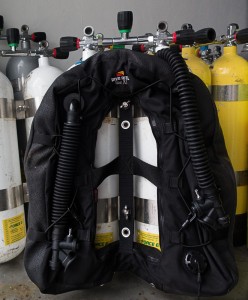Dive Locker
I think that most divers are like me, in that we have a love/hate relationship with our equipment. Some stuff we love, and some stuff is a disappointment. 🙁 Okay, some of it just pisses us off because it just does not work for us, for whatever reason? We are all searching for our own Goldilocks Gear, for the way we dive. So, these are some of the items in my dive locker that I am truly excited about, and work Just Right for me!!
Dive Rite Tech Buttplate
I like to segregate equipment, so I can locate it easily, in places that makes sense to me. I use my reel with my left hand, so I keep it on my left side. I will carry wet notes, Jon Line, small items, and spare masks in my pockets, but I don't want to have big pockets full of crap where I can't get to what I want.
I want my lights in one spot, my Strobes in another, SMB's in another, and reels & spools by themselves. Now, if I am carrying side slung cylinders, I want them clipped off separate from the rest of my stuff. I don't want a D-ring with 6 clips on it, with a mixture of everything I own. If I am in a hurry, I can't find anything that way.
So, how do I find space for all that gear? Dive Rite makes a Tech Buttplate that I really, really like. It gives me two wide "Rings", just below the D-Rings on the harness waist strap. On my crotch strap, I have added a Butterfly clip, just below the Tech Buttplate pad. That gives me 6 places to clip stuff off to, 3 on each side. For me, this works.
Shearwater Perdix AI (Air Integration)
I cannot say enough good stuff about the new Shearwater Perdix AI (Air Integrated) Dive Computer. Not only is this the best dive computer made today, but Shearwater is a company that is dedicated to diving, and the dive community. I have been diving Shearwater computers since they made their first model, the Pursuit.
When I teach technical dive classes, in the classroom we download our dives from my Perdix AI to the Shearwater Dive Log, and look at the particulars of dive. This makes the Perdix AI an incredibly valuable learning tool, not just in my classroom, but for any diver with a laptop or desktop computer. This is also why I strongly recommend that students use a Shearwater computer, at least for class.

The limiting factors we have to deal with while planning or executing any dive are the decompression, oxygen, and gas supply. With the Perdix AI, all of this data is available for post dive review, in detail.
As far as the Shearwater company itself, they are dedicated to helping divers better understand diving. On their website, they regularly post informative cutting edge articles written by knowledgeable experts. New articles are announced in the Newsletter, and I strongly recommend that you sign up, even if you are not diving a Shearwater. They also have YouTube videos, to help you get the most out of your dive computer.
These are a few of the Shearwater articles, and a video that I personally like.
Shearwater and the CNS Oxygen Clock
Oxygen Seizures at PO2 less than 1.6
Flexible Control of Decompression Stress
Eliminating the Helium Penalty
Video of Petrel 2 Compass Features
Aqua Lung Fusion Bullet Drysuit
Most of the time here in Florida I don't really need a drysuit. However, sometimes I travel and dive in places where a wetsuit is just not practical, or reasonable. I just got back from some Lake Michigan dives where the temps were in the 40's, and next summer I am going back to the Andrea Doria!
My new favorite drysuit is the New Fusion Bullet by Aqua Lung!! It is a "self donning", two layer design with silicon seals, zippered legs, and is very well made. Aside from features like the Seal Lock Technology, replaceable seal system that prevents a torn seal from ending your dive day, and the rings for Dry Gloves, and the bellows pockets, there are two additional things I really love about this suit!
This suit is comfortable! The new AirCore Inner layer is awesome. You don't feel like you are wearing a Zip Lock bag, and it moves with you. When the suit compresses, there are no hot spots. The silicone seals are as comfortable as the rest of the suit. I have been in a lot of drysuits over the years, and I can say this is the most comfortable suit I have been in.
If you have been diving with me, you know I am all about minimizing my expenditure of energy, to minimize CO2. I want to be as hydrodynamic as possible, so I don't have to physically exert myself any more than necessary. This suit is very hydrodynamic, and inside the wreck, the outer layer is very snag resistant.
All in all, I like this suit a lot, and it is not stupid expensive.
Mares Power Plana “Tech” Fins
Okay, in many ways, fins are fins, but fins are like shoes. They need to fit, and feel good while they are getting you where you are going. The Mares Power Plana Fins are the Mares Tech product for divers. They are of the new generation of rubber fins that are actually comfortable, like the Hollis F-1, or the Apeks RK3. For me, the Power Plana's are very comfortable, sized right for wreck penetration, snag resistant, and have pretty good kick. The thing that separates them from the rest of the pack is the straps, which are rubber, not stainless springs. The straps have a rubber tab with a loop, for pulling the fins off. When I remove the fins, I put the loop over my thumb, and can easily carry them up the ladder. For me, this not only makes them more comfortable, but I can have them off in a heartbeat, which is a nice advantage in crappy weather. On the down side, the rubber straps need to be replaced annually, if not sooner depending on how much you dive.
Dyneema Gloves
If the water is cold, then I will use neoprene, or dry gloves appropriate to the degree of coldness. Manual dexterity is important, and cold hands are not conducive to getting the job done.
However, I do a lot of warm water diving these days and I am a glove guy, regardless of how cold the water is, unless the wearing of gloves is prohibited by the Law. IMHO gloves are necessary protection for wreck divers and hunters, but some reef watchers do not use, or need gloves,
Regular old neoprene gloves, for warm water diving, do not protect me very well, they don't hold up very well, and they are expensive. For me, that is not such a good combination? What usually happens to me, is that the neoprene wears through at the fingertips, and that means you have hand protection, except where you need it. Nice. For this reason, they do not last long, and they don't offer much protection against cuts or punctures.
The latest thing in dive glove tech is gloves made from dyneema. Dyneema is a fabric similar to kevlar, but at least for diving, it is better. It is light weight, puncture resistant, and cut resistant. Dyneema has several uses for spearos, but dyneema gloves rock!! They work extremely well for wreck divers, for all the reasons they work for spearos. They protect your hands, but they are very tactile.
There are a bunch of manufacturers, like Hammerhead, Hatch, and Omer, that you can find at your dive shop, but there are also generic "cut resistant" gloves at Home Depot, Lowes, etc. I am not sure which brand is "best", but trust me, dyneema gloves will protect your hands like nothing else out there, and they last!!
Olde Style Jon Line
When it comes to spending money on dive gear, I try not to look at prices, because it might keep me from buying something I really want. However, I don't want to spend money on something that does not work as well, as something less expensive. I am all about function and utility.
This is the case with Jon Lines. There are expensive Jon Lines out there, they are always made of synthetic straps and metal hardware. I do not like that stuff! I have a 50 foot coil of 1/4" sisal line from Home Depot in my garage, and I cut off a 6'-8' piece, and I splice an eye in each end. When I coil it around my hand, and put a double end clip on it, I can stow it anywhere.
Anchor lines are synthetic fiber, like Dacon or Nylon, and they are slippery when wet. If I use a strap made of Nylon or Dacron, and attach it to an anchor line made of similar stuff, it wants to slip. Sisal is a natural fiber, it grips the anchor line well, it is easy to carry, it is biodegradable, and it is cheap. It is also the way Jon Hulburt first envisioned it!! If I lose it, loan it out, or I gift it to someone, it is no big deal.
If you want to make your own eye splices, below are some links. If you still need help, come find me and I will help you. It is easy.
Dive Rite LX20 Dive Light
I remember a time when my old Darrell Allan light was the wreck diving standard. It was not bright at all, but you could also use it as a hammer!! It was a big can that used like 10 alkaline batteries, and sometimes the bulb would fall out of the socket in the middle of a dive. It was nicknamed "The Prince of Darkness". If you carried a Darrel Allen light, everyone knew you were a serious wreck diver. It was status. That was then, and this is now!!!!!
Modern lights are awesome!! They can give us more light in a smaller package, and now thanks to LED's, they burn longer, and at a hotter temperature than we ever imagined!!! For wreck diving, I want my Primary Light to provide lots of light, rugged, small, and with a decent burn time!!!
It seems like everyone is making dive lights, and a lot of them are pretty good. If I am deep in a wreck, I want to have an awesome Primary Light with a minimum of 1000 lumens, but even truly awesome lights can fail. If my Primary goes down, I can't afford to have my old Darrel Allen as a backup to find my way out!! So, I don't just want an awesome Primary Light, I want an awesome Primary, a great Secondary, and great Backup Light, as a minimum.
I love the Dive Rite LX20. It throws an amazing amount of light, it is relatively small, great switching, great burn time, and it is rugged. On the highest power setting, it is 20,000 lux!!!! It even comes with a Goodman handle setup, that I don't use, but some people like? If you want one really good light, this is it. This is my Primary light!!
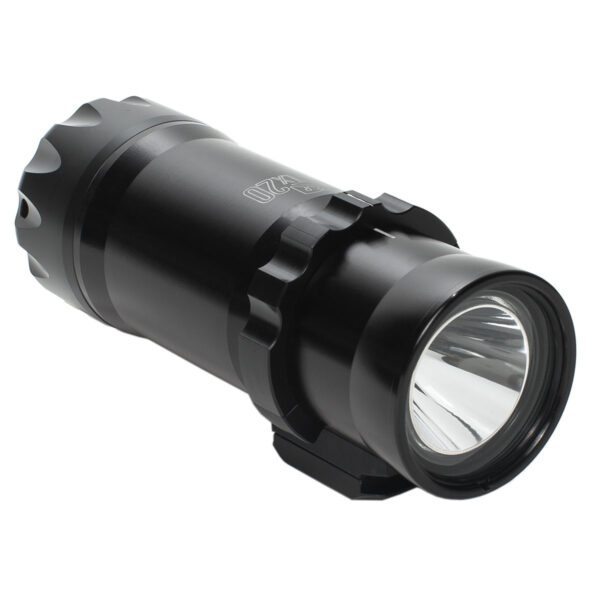
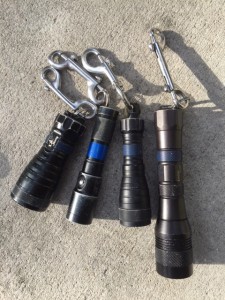
For my Secondary and Backup, I use 1000 lumen rechargeable lithium ion lights. There are a bunch of manufacturers, pick one. When I jump in the water, I essentially have a bouquet of very bright, small, reliable, inexpensive 1000 lights, and one really good 20,000 lux killer light!!!
I do not use canister lights, because they are too big and complicated for me and the diving I do. I wonder whatever happened to my old Darrell Allan light???
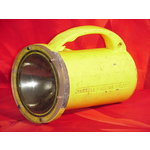
Dive Rite Slide Lock Primary 250′ Reel
This is my new favorite reel! First off, the Dive Rite Slide Lock Primary 250' Reel is very compact, and simple. It is smaller than most 150' reels, and very low profile, which makes it a pleasure to carry. The clip is very cool, and low profile, not some piece of crap. I really like this new slide lock thing that Dive Rite has on this. It is a spring loaded lock that you can open and manually hold open, lock it open, or lock it closed. It is easy to work, and it beats the hell out of locking screws, which just eat up too much time to operate. The SL is faster, better, regardless if I am blowing a bag, or running a line inside a wreck. If I am on a reel, time is really of the essence. For a lot of my dives, the 150' of line is not quite enough, but a big 400' reel is overkill. The 250' not only works, but like I said it is very low profile.
Dive Rite is a first class manufacturer with a strong base of loyal fans.
Apeks Tek3 Regulator Set
Over the years I have tried probably every brand of regulator out there. Seriously, all of the major manufacturers make a descent regulator, however if there is one single piece of equipment we all obsess over as divers, it is our regulators. It is our life support, and the most important purchase most divers make. Regulator failure is a serious issue that will cancel or turn a dive in a heartbeat, so we all want the best regulators we can get our hands on.
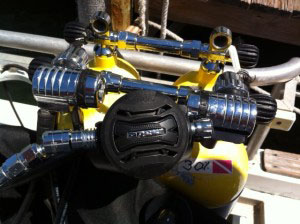 IMHO, the best regulators I have ever used are the ones I am currently using, the Apeks Tek3 first stages with the XTX 50 second stages. I love these regulators for a bunch of reasons. They are rugged, and durable, both of which are important to me because I am kind of hard on gear.
IMHO, the best regulators I have ever used are the ones I am currently using, the Apeks Tek3 first stages with the XTX 50 second stages. I love these regulators for a bunch of reasons. They are rugged, and durable, both of which are important to me because I am kind of hard on gear.
At the same time, the Tek3 first stages are specifically designed for use with double cylinders, with a right hand regulator and a left hand regulator. You can use them with the first stages horizontal or vertical, depending on how you want to route your LP & HP hoses. Regardless of which way you orient the first stage, they are very low profile. Most important, they are extremely reliable, which actually to me means low maintenance.
WOB (Work of Breathing) is a major factor in the body's creation and elimination of CO2. The XTX 50 second stages are reliable, adjustable, and breathe like I want them to breathe, even at depth, thereby minimizing my WOB. Aside from that, they also have a cool little deal with the purge button that gives a half purge, or Purge Light, when you want it. I can't believe someone did not come up with this sooner, but I like it.
I guess the real test is how well any regulator works in deep water, and I am very happy with the Tek3/XTX50 combination. Apeks is a solid company, they are dedicated to diving, and they make their own products in the UK.
Apeks Lifeline Spools
I use spools far more than I use reels, just because I like their simplicity. For me, stainless spools are robust and shiny, but they are too heavy and easy to drop. If you fumble and drop them, they are headed to the bottom. Plastic spools are almost neutrally buoyant, which is cool, but they break. This means I lose them, or they are just another piece of broken crap in my garage. I found one on the bottom just yesterday.
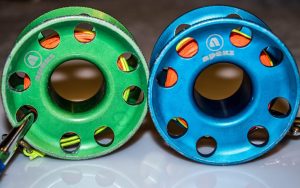
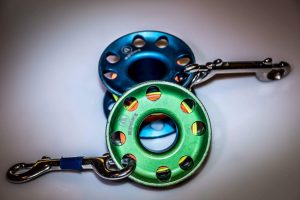
The Apeks Lifeline Spools are awesome!! They are aluminum, which gives them great buoyancy, and they are robust!! They have little grooves on the edges, like milled coins, which makes them feel good, and easy to control. The finger hole is big, and smooth, and the spool does not come with so much line on it that you can't clip into the reel. It is easy to clip to this reel. I also love the line that comes with them, which is strong, lightweight, and feels very slick. I have the 150', and 100' versions. They are color coded, with green being 100', and blue 150'.
On the down side, these things are expensive, like the price of a reel! I focus on how sexy they are, and try not to dwell on the price. In addition, I don't care for the end of the line, which has a sewn connection? On my reals, I cut the sewn connection, slip on a 5/8" solid brass ring, and close it with a fisherman's know.
Tektite Strobes
I love to use strobe lights on wrecks!!! They are a fantastic navigation tool, and the brighter they are the better they do what it is I want them to do. I use them to mark the anchor line or stage bottles, as well as for navigation inside or outside the wreck. I regularly use more than one at a time. Deep inside a dark wreck, nothing gives me that warm and fuzzy feeling on the way out, like seeing the strobe in the distance.
Doc Edgerton invented the strobe light in 1931, but the strobe lights themselves for use underwater have been kind of disappointing until recent history. If you watch my Andrea Doria video from 1991, you will notice that the strobe light I drop at the beginning of the dive to mark my entrance/exit from the stairwell, is not working by the time I am ready to leave. At the other end of the stairwell, I use a flashlight instead of a strobe, simply because I did not own another strobe that was working that day. Reliability is important if you are using it for navigation, and reliability used to be a tall order.
The latest strobe lights from Tektite are the best I have ever used. They are rugged, bright, and reliable. They have a few models that work for me. The Strobe 200 uses 2 C-cell alkaline batteries. The multi function Strobe 3500., runs on 3 C-cell alkaline batteries. My favorite is the Tekna Lite 6 Strobe, which runs on 2- CR123A Lithium batteries. I think so much of the Tekna Lite 6, and I think that strobes are so important for wreck divers, that I give one to each of my Advanced Wreck, and Combo Advanced Wreck/Deco students.
Dive Rite Rec XT 45# Wing
I will try to not make this sound like a rant.
The problem with Wing BCD’s is that most of them are just poorly designed. The Old Horseshoe design is terrible, because gas can only move around when you are in a head up position, and big slugs of gas moving around mess with your trim. With the doughnut design, the wing gas moves around better, and the wing can be designed a little narrower for the same amount of lift, and narrow is good. A big, wide Taco Wing, with two big pontoons of gas inflated Wing wrapped around both sides of your double cylinders, makes navigating restrictions difficult, adversely impacts your hydrodynamics, causes you to expend more energy, and use more gas than necessary. All this increases your exposure to DCS, oxygen toxicity, and CO2 narcosis, among other bad things. The more the lift, the wider the wing, for any given design.
IMHO, I do not need 60# of lift, and I do not need the big, wide 60# Taco associated with the big, wide 60# wing!! If I were properly weighted for the dive (as I should be), and diving my big twin Blue Steel 120's, with two AL80's for deco gas, that is a lot of gas by any standard you may apply. If I was to breath all of that gas on the dive, my weight differential would only be (400 cf of Air/Nitrox x 0.08 lbs/cf of gas = 32 lbs) 32 lbs. That is a pretty big dive from a gas usage standpoint, and it would be significantly less than 32# if we were to use Trimix, which is of course lighter than air. So, with some extra lift for poor initial weighting contingency, I like something like 45# of lift, as a max, for the kind of open circuit diving I do.
When it comes to deeper diving, I don't need more lift, but I might need a Dual Bladder? A Dual Bladder Wing is not simply a good idea, it is essential for deep deco dives. Simply put, on deep dives we do not have the time to screw around with alternate ascent plans involving Lift Bags and SMB's, in the event of a torn corrugated hose or broken elbow, nut, whatever. So, a Dual Bladder Wing is good, but most Dual Bladder Wings are huge, and wide, and heavy, and 60#!!!! A corrugated hose over each shoulder is only like the cherry on top of the Crap Sundae.
So, for deeper diving I want to start out being weighted properly, and I want a Dual Bladder Wing that is no more than 45# of lift, but with as small a profile as possible, and because I am a wreck diver, I also need it to be rugged. The Dive Rite Rec XT, which offers the Dual Bladder option, works very well for me. It is a rugged, Dual Bladder Wing with 45# of lift, with a side mount Secondary Bladder corrugated hose that I hardly even notice is there.
When I come out of a wreck, the sides of my Wing are always dirty, simply because I make a lot of wreck contact. The cover on the Rec XT is uber tough!! But the Rec XT also has adjustable bungees to keep the sides trimmed up, close to my sides, however I want them, which allows me to keep my profile narrow. But the bungees are on my side of the Wing, not the edges of the Wing, where they would get all scuffed up.
The bottom line is that the Dive Rite Rec XT 45# Wing is a rugged, low profile, adjustable, Dual Bladder Wing that is intelligently designed, and built to last. Dive Rite is solid company, with great customer service, and a loyal following. Aside from all that, the Rec XT is reasonably priced.
